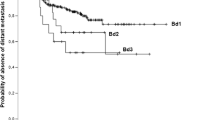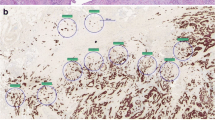Abstract
Tumor budding in colorectal cancer (CRC) is recognized as a valuable prognostic factor but its translation into daily histopathology practice has been delayed by lack of agreement on the optimal method of assessment. Within the context of the Swiss Association of Gastrointestinal Pathology (SAGIP), we performed a multicenter interobserver study on tumor budding, comparing hematoxylin and eosin (H&E) with pan-cytokeratin staining using a 10 high power field (10HPF) and hotspot (1HPF) method. Two serial sections of 50 TNM stage II-IV surgically treated CRC were stained for H&E and pan-cytokeratin. Tumor buds were scored by independent observers at six participating centers in Switzerland and Austria using the 10HPF and 1HPF method on a digital pathology platform. Pearson correlation (r) and intra-class correlation coefficients (ICC) comparing scores between centers were calculated. Three to four times more tumor buds were detected in pan-cytokeratin compared to H&E slides. Correlation coefficients for tumor budding counts between centers ranged from r = 0.46 to r = 0.91 for H&E and from r = 0.73 to r = 0.95 for pan-cytokeratin slides. Interobserver agreement across all centers was excellent for pan-cytokeratin [10HPF: ICC = 0.83 and 1HPF: ICC = 0.8]. In contrast, assessment of tumor budding on H&E slides reached only moderate agreement [10HPF: ICC = 0.58 and 1HPF: ICC = 0.49]. Based on previous literature and our findings, we recommend (1) pan-cytokeratin staining whenever possible, (2) 10HPF method for resection specimens, and (3) 1HPF method for limited material (preoperative biopsy or pT1). Since tumor budding counts can be used to determine probabilities of relevant outcomes and as such more optimally complement clinical decision making, we advocate the avoidance of cutoff scores.



Similar content being viewed by others
Abbreviations
- CRC:
-
Colorectal cancer
- H&E:
-
Hematoxylin and eosin
- HPF:
-
High power fields
- ICC:
-
Intra-class correlation coefficient
- ITB:
-
Intra-tumoral budding
- r :
-
Pearson correlation coefficient
- SAGIP:
-
Swiss Association of Gastrointestinal Pathology
- UICC:
-
Union for International Cancer Control
- TNM stage:
-
Tumor Node Metastasis stage
References
Choi DH, Sohn DK, Chang HJ, Lim SB, Choi HS, Jeong SY (2009) Indications for subsequent surgery after endoscopic resection of submucosally invasive colorectal carcinomas: a prospective cohort study. Dis Colon Rectum 52:438–445. doi:10.1007/DCR.0b013e318197e37f
Compton C (2014) Pathology and prognostic determinants of colorectal cancer. In: UpToDate, Basow, DS (Ed), UpToDate, Waltham, MA, USA
Dirnhofer S, Bubendorf L, Lehr H-A, Landau B, Zenklusen HR (2011) SGPath Quality Guidelines. 1st ed. Rheinfelden, Switzerland: lebensart003:78–80
Giger OT, Comtesse SC, Lugli A, Zlobec I, Kurrer MO (2012) Intra-tumoral budding in preoperative biopsy specimens predicts lymph node and distant metastasis in patients with colorectal cancer. Modern Pathol: Off J U S Can Acad Pathol, Inc 25:1048–1053. doi:10.1038/modpathol.2012.56
Gospodarowicz MK, O’Sullivan B, Sobin LH (2006) Prognostic factors in cancer, 3rd edn. Wiley, New York, pp 267–279
Hase K, Shatney C, Johnson D, Trollope M, Vierra M (1993) Prognostic value of tumor “budding” in patients with colorectal cancer. Dis Colon Rectum 36:627–635
Horcic M, Koelzer VH, Karamitopoulou E, Terracciano L, Puppa G, Zlobec I, Lugli A (2013) Tumor budding score based on 10 high-power fields is a promising basis for a standardized prognostic scoring system in stage II colorectal cancer. Hum Pathol 44:697–705. doi:10.1016/j.humpath.2012.07.026
Karamitopoulou E, Zlobec I, Kolzer V, Kondi-Pafiti A, Patsouris ES, Gennatas K, Lugli A (2013) Proposal for a 10-high-power-fields scoring method for the assessment of tumor budding in colorectal cancer. Modern Pathol: Off J U S Can Acad Pathol, Inc 26:295–301. doi:10.1038/modpathol.2012.155
Kevans D, Wang LM, Sheahan K, Hyland J, O’Donoghue D, Mulcahy H, O’Sullivan J (2011) Epithelial-mesenchymal transition (EMT) protein expression in a cohort of stage II colorectal cancer patients with characterized tumor budding and mismatch repair protein status. Int J Surg Pathol 19:751–760. doi:10.1177/1066896911414566
Koelzer VH, Zlobec I, Lugli A (2014) Tumor budding in the clinical management of colon and rectal cancer. Colorectal Cancer 3:387–403. doi:10.2217/crc.14.21
Lugli A, Karamitopoulou E, Zlobec I (2012) Tumour budding: a promising parameter in colorectal cancer. Br J Cancer 106:1713–1717. doi:10.1038/bjc.2012.127
Lugli A, Vlajnic T, Giger O, Karamitopoulou E, Patsouris ES, Peros G, Terracciano LM, Zlobec I (2011) Intratumoral budding as a potential parameter of tumor progression in mismatch repair-proficient and mismatch repair-deficient colorectal cancer patients. Hum Pathol 42:1833–1840. doi:10.1016/j.humpath.2011.02.010
Mitrovic B, Schaeffer DF, Riddell RH, Kirsch R (2012) Tumor budding in colorectal carcinoma: time to take notice. Modern Pathol: Off J U S Can Acad Pathol, Inc 25:1315–1325. doi:10.1038/modpathol.2012.94
Morodomi T, Isomoto H, Shirouzu K, Kakegawa K, Irie K, Morimatsu M (1989) An index for estimating the probability of lymph node metastasis in rectal cancers. Lymph node metastasis and the histopathology of actively invasive regions of cancer. Cancer 63:539–543
Nakadoi K, Tanaka S, Kanao H, Terasaki M, Takata S, Oka S, Yoshida S, Arihiro K, Chayama K (2012) Management of T1 colorectal carcinoma with special reference to criteria for curative endoscopic resection. J Gastroenterol Hepatol 27:1057–1062. doi:10.1111/j.1440-1746.2011.07041.x
Nakamura T, Mitomi H, Kikuchi S, Ohtani Y, Sato K (2005) Evaluation of the usefulness of tumor budding on the prediction of metastasis to the lung and liver after curative excision of colorectal cancer. Hepato-Gastroenterology 52:1432–1435
Ohtsuki K, Koyama F, Tamura T, Enomoto Y, Fujii H, Mukogawa T, Nakagawa T, Uchimoto K, Nakamura S, Nonomura A, Nakajima Y (2008) Prognostic value of immunohistochemical analysis of tumor budding in colorectal carcinoma. Anticancer Res 28:1831–1836
Okuyama T, Oya M, Ishikawa H (2002) Budding as a risk factor for lymph node metastasis in pT1 or pT2 well-differentiated colorectal adenocarcinoma. Dis Colon Rectum 45:628–634
Prall F, Nizze H, Barten M (2005) Tumour budding as prognostic factor in stage I/II colorectal carcinoma. Histopathology 47:17–24. doi:10.1111/j.1365-2559.2005.02161.x
Puppa G, Senore C, Sheahan K, Vieth M, Lugli A, Zlobec I, Pecori S, Wang LM, Langner C, Mitomi H, Nakamura T, Watanabe M, Ueno H, Chasle J, Conley SA, Herlin P, Lauwers GY, Risio M (2012) Diagnostic reproducibility of tumour budding in colorectal cancer: a multicentre, multinational study using virtual microscopy. Histopathology 61:562–575. doi:10.1111/j.1365-2559.2012.04270.x
Rogers AC, Gibbons D, Hanly AM, Hyland JM, O’Connell PR, Winter DC, Sheahan K (2013) Prognostic significance of tumor budding in rectal cancer biopsies before neoadjuvant therapy. Modern Pathol: Off J U S Can Acad Pathol, Inc. doi:10.1038/modpathol.2013.124
Shinto E, Jass JR, Tsuda H, Sato T, Ueno H, Hase K, Mochizuki H, Matsubara O (2006) Differential prognostic significance of morphologic invasive markers in colorectal cancer: tumor budding and cytoplasmic podia. Dis Colon Rectum 49:1422–1430. doi:10.1007/s10350-006-0595-1
Sobin LH, Gospodarowicz MK, Wittekind C, International Union against Cancer (2010) TNM classification of malignant tumours. Wiley-Blackwell, Chichester
Tateishi Y, Nakanishi Y, Taniguchi H, Shimoda T, Umemura S (2010) Pathological prognostic factors predicting lymph node metastasis in submucosal invasive (T1) colorectal carcinoma. Modern Pathol: Off J U S Can Acad Pathol, Inc 23:1068–1072. doi:10.1038/modpathol.2010.88
Ueno H, Murphy J, Jass JR, Mochizuki H, Talbot IC (2002) Tumour ‘budding’ as an index to estimate the potential of aggressiveness in rectal cancer. Histopathology 40:127–132
Wang HS, Liang WY, Lin TC, Chen WS, Jiang JK, Yang SH, Chang SC, Lin JK (2005) Curative resection of T1 colorectal carcinoma: risk of lymph node metastasis and long-term prognosis. Dis Colon Rectum 48:1182–1192. doi:10.1007/s10350-004-0935-y
Wang LM, Kevans D, Mulcahy H, O’Sullivan J, Fennelly D, Hyland J, O’Donoghue D, Sheahan K (2009) Tumor budding is a strong and reproducible prognostic marker in T3N0 colorectal cancer. Am J Surg Pathol 33:134–141. doi:10.1097/PAS.0b013e318184cd55
Yamauchi H, Togashi K, Kawamura YJ, Horie H, Sasaki J, Tsujinaka S, Yasuda Y, Konishi F (2008) Pathological predictors for lymph node metastasis in T1 colorectal cancer. Surg Today 38:905–910. doi:10.1007/s00595-007-3751-x
Zlobec I, Hadrich M, Dawson H, Koelzer VH, Borner M, Mallaev M, Schnuriger B, Inderbitzin D, Lugli A (2013) Intratumoural budding (ITB) in preoperative biopsies predicts the presence of lymph node and distant metastases in colon and rectal cancer patients. Br J Cancer. doi:10.1038/bjc.2013.797
Acknowledgments
The authors thank Mary Economou and Caroline Hammer from the Translational Research Unit, Institute of Pathology, University of Bern for excellent technical support.
Conflicts of interest
The authors have no relevant affiliations or financial involvement with any organization or entity with a financial interest in or financial conflict with the subject matter or materials discussed in the manuscript. This includes employment, consultancies, honoraria, stock ownership or options, expert testimony, grants or patents received or pending, or royalties.
Authors contributions
VHK obtained, reviewed, and categorized histopathological data, scored tumor budding, performed data interpretation, and together with IZ drafted the manuscript; IZ obtained and categorized clinicopathological data, performed data interpretation and statistical analysis. AL reviewed cases and together with VHK conceived the study and study design and performed manuscript editing; MDB, GC, KD, FO, GP, WS, and LT scored the cases, and reviewed and approved the final manuscript. HD obtained, reviewed, and categorized histopathological data, reviewed and approved the final manuscript. MDB, DI, MH, and BS obtained, reviewed, and categorized clinical data, and reviewed and approved the final manuscript. All authors have read and given approval of the final manuscript.
Compliance with ethical standards
The use of patient material has been approved by the local ethics committee of the Insel University Hospital (16-03-12).
Author information
Authors and Affiliations
Corresponding author
Additional information
Viktor H. Koelzer and Inti Zlobec contributed equally to this work.
Electronic supplementary material
Below is the link to the electronic supplementary material.
Supplemental Fig. 1
Study design. 198 colorectal cancer patients treated at the Bern University hospital were initially entered into the study. Clinical data were retrieved from patient records and slides were re-reviewed by an expert gastrointestinal pathologist and two residents. 50 cases were randomly selected for further study, serial H&E and pan-cytokeratin stained sections were made and digitized using an Aperio Image Scope. Digital slides were distributed to six independent academic centers in Switzerland and Austria and evaluated separately for tumor budding using a virtual pathology platform. Tumor budding scores for H&E and pan-cytokeratin from each center were assessed for interobserver variability for a 10HPF and hotspot method. (GIF 156 kb)
ESM 1
(DOCX 41 kb)
Rights and permissions
About this article
Cite this article
Koelzer, V.H., Zlobec, I., Berger, M.D. et al. Tumor budding in colorectal cancer revisited: results of a multicenter interobserver study. Virchows Arch 466, 485–493 (2015). https://doi.org/10.1007/s00428-015-1740-9
Received:
Revised:
Accepted:
Published:
Issue Date:
DOI: https://doi.org/10.1007/s00428-015-1740-9




